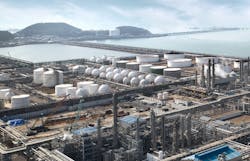Eni, LG Chem break ground on South Korean biorefinery
Key Highlights
"Will contribute to reaching our 2030 target to increase our [system-wide] biorefining capacity to over 5 million tpy."
Also progressing with planned conversion of idled 84,000-b/d conventional refinery in Livorno, Tuscany, into what will become Italy’s third biorefinery.
LG-Eni BioRefining Co. Ltd.—a joint venture of Eni SPA subsidiary Enilive SPA (49%) and LG Chem Ltd. (51%)—has started construction of the partners’ proposed grassroots biorefinery at LG Chem’s Daesan integrated petrochemical complex in Seosan, Chungcheongnam-do Province, South Korea, 80 km southwest of Seoul (OGJ Online, Jan 19, 2024).
Official groundbreaking activities for the new hydrotreated vegetable oil (HVO) and sustainable aviation fuel (SAF) production plant—the first of its kind in South Korea—began on Aug. 4, Eni and LG Chem said in separate releases.
Following its completion in 2027, the biorefinery will use Eni-Honeywell UOP LLC codeveloped proprietary Ecofining technology to flexibly process about 400,000 tonnes/year (tpy) of renewable materials to produce SAF, HVO, and bionaphtha, the companies said.
The partners confirmed the new plant will specifically use a feedstock of sustainable vegetable oils such as used cooking oils, among other unidentified bio-based waste and residues.
Start of construction on the Daesan renewables plant follows the partners’ September-2023 launch of technical and economic feasibility assessments for the project, which came as part of both companies’ shared objective to meet growing demand for sustainable, low-carbon fuels and plastics as they advance their common goal of competitively achieving sustainable development of decarbonized products and carbon neutrality in line with the global energy transition to net-zero emissions (OGJ Online, Sept. 14, 2023).
“Together with [Eni renewable fuels] plants that are already operational in Italy and [the US], and with [our] new biorefining plants under construction in Italy and Malaysia, the upcoming biorefining plant in Daesan will contribute to reaching our 2030 target to increase our [system-wide] biorefining capacity to over 5 million [tpy], with the potential to produce more than 2 million [tpy] of SAF,” said Stefano Ballista, Enilive’s chief executive officer.
While Eni and LG Chem revealed no further details regarding engineering, procurement, and construction activities on the new biorefinery, Eni confirmed in its 2024 annual report that the JV awarded a contract for the project’s construction to an unidentified contractor sometime between December 2024 and February 2025.
Eni’s renewables ambition
In addition to conversions of its former Venice and Gela conventional crude oil refineries in 2014 and 2019, respectively, Eni is also progressing on Italy’s northwestern coast with the planned conversion of the idled 84,000-b/d conventional refinery in Livorno, Tuscany, into what will become Italy’s third biorefinery. The plant is targeted for startup in 2026 with a nameplate production capacity of 500,000 tpy (OGJ Online, Sept. 10, 2024).
The operator has also said it could reach final investment decision this year on a project to convert its existing 180,000-b/d Sannazzaro de' Burgondi conventional refinery in Italy’s Pavia province and the Priolo Gargallo steam-cracking plant in eastern Sicily.
If approved, Eni said the Enilive-operated Sannazzaro biorefinery would begin producing 550,000 tpy of renewable fuels by December 2027, with Eni subsidiary Versalis SPA’s planned Priolo biorefinery to follow by yearend 2028 at a nameplate production capacity of 500,000 tpy (OGJ Online, June 24, 2025).
Eni also has partnered with Petroliam Nasional Berhad’s (Petronas) Petronas Mobility Lestari Sdn. Bhd. (PMLSB) and Euglena Co. Ltd. of Japan for a jointly held grassroots biorefinery to be built in the Pengerang Integrated Complex (PIC) at Johor in southern Peninsular Malaysia. This biorefinery will be equipped to flexibly process about 650,000 tpy of waste and residue biofeedstocks—including vegetable oils, animal fats, and waste from the processing of vegetable oils—into SAF and HVO by second-half 2028 (OGJ Online, Jan. 14, 2025).
About the Author
Robert Brelsford
Downstream Editor
Robert Brelsford joined Oil & Gas Journal in October 2013 as downstream technology editor after 8 years as a crude oil price and news reporter on spot crude transactions at the US Gulf Coast, West Coast, Canadian, and Latin American markets. He holds a BA (2000) in English from Rice University and an MS (2003) in education and social policy from Northwestern University.

